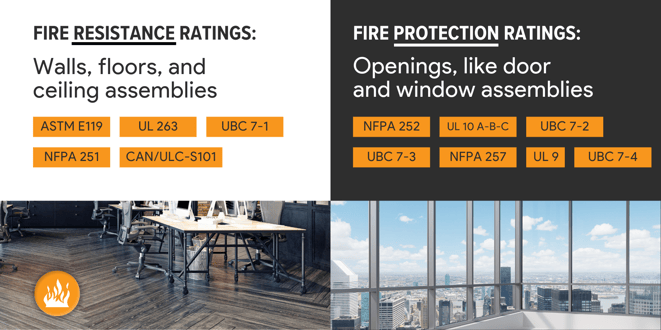In case of a fire, time is precious — time for firefighters to arrive and time for occupants to evacuate. Fire resistance ratings indicate how much time you will have for evacuation, depending on the products and assemblies used in the building’s construction.
Fire resistance ratings and more stringent building codes have helped to reduce fires in office properties by 71% from 1980 to 2011, according to the National Fire Protection Association (NFPA).
By understanding how assemblies will perform in a fire, you can make informed decisions to meet these stricter building codes and, more importantly, offer the needed time to protect occupants.
In this article, you’ll learn how fire resistance ratings are different from fire protection ratings, how fire testing should be completed, and how to calculate fire resistance ratings.
What Are Fire Resistance Ratings?
Fire resistance ratings (FRR) are defined as the time in minutes or hours that a material or assembly can withstand fire exposure under specific conditions. The three key factors are:.png?width=700&height=350&name=Fire%20Resistance%20Ratings%20Blog%20Graphics%20(2).png)
- Time until failure
- Temperature required to cause failure
- Strength of load capacity at a certain temperature
The building code might require a FRR of 90. That means that the assembly must resist fire, in each of the three ways above, for 90 minutes.
Fire Resistance Rating vs Fire Protection Rating
Fire resistance ratings are commonly assigned to walls, floors, and ceiling assemblies. These assemblies are tested to ASTM E119 or UL 263 standards, which are typically more stringent than the standards required for fire protection.
There can be no passage of flame or gasses hot enough to ignite cotton waste on the unexposed side, and the temperature on the unexposed surface of the assembly cannot increase more than 250° F (average) or 325° F (individual) above the thermal couple temperature. 
Typical fire-resistant construction materials include steel, concrete, gypsum, and plaster.
Fire protection ratings most often apply to openings, such as door and window assemblies. These products are tested to NFPA 252, NFPA 257, UL 10 A-B-C (doors), and UL 9 (windows) standards, where there are no limitations on the amount of heat transferred from one side to the other.
Fire-protective glazing is one of the most common materials used on door and window openings.
Testing Methods for Fire Resistance Ratings
Testing should always be completed by an independent testing laboratory accredited by institutions such as the International Accreditation Service (IAS).
Fire Resistance Rating Tests
The International Building Code (IBC) 703.0 lists six acceptable methods to determine the fire resistance of assemblies. The most common is testing completed in accordance with ASTM E119 or UL 263 standards.
Fire Tests of Building Construction and Materials (ASTM E119, UL 263, UBC 7-1, NFPA 251, CAN/ULC-S101)
The ASTM E119 fire test is used to evaluate the duration for which certain building elements can contain a fire, retain their structural integrity, or exhibit both properties during a predetermined test exposure.
Using a full-scale vertical furnace, full-scale horizontal furnace, or pilot-scale horizontal furnace, test assemblies are monitored for 45 minutes to several hours based on the fire rating being tested.
Fire Protection Rating Tests
Fire Tests of Door Assemblies (NFPA 252, UL 10 A-B-C, UBC 7-2, UBC 7-3)
Using a full-scale vertical furnace, fire door assemblies are tested to determine a rating for the door based on the time of fire spread through door openings in fire-resistance-rated walls. Fire-rated doors are a requirement for most buildings to adhere to the IBC.
Fire Tests of Windows and Glass Block Assemblies (NFPA 257, UL 9, UBC 7-4)
This test uses a full-scale vertical furnace to evaluate fire window assemblies, including windows, glass blocks, and other light-transmitting assemblies, intended to be used to retard the spread of fire through openings in fire-resistance-rated walls.
Calculating Fire Resistance Ratings
All the tests listed above use the same standard time/temperature curve to determine the exposure temperature required for the test.
The assembly must be able to resist fire for the entire exposure period using the criteria below to measure fire resistance..png?width=700&height=350&name=Fire%20Resistance%20Ratings%20Blog%20Graphics%20(3).png)
- Stability: This criterion measures the assembly’s ability to withstand the applied load for the duration of the test.
- Integrity: This criterion measures the assembly’s ability to stay intact without cracks or fissures when it is exposed to fire.
- Insulation: This criterion measures the ability of the assembly to slow the transmission of heat from one side to the other.
Looking Beyond Fire Resistance Ratings
When it comes to fire testing, there are nearly unlimited factors in the field that can cause different outcomes than testing in a controlled laboratory environment. Construction quality, weather, and use of the structure are all factors that can come into play.
That said, fire testing is a great way to compare and select materials or assemblies using the information available before and during the construction process. It is the most reliable way to meet building codes and to feel confident in the ratings of assemblies.
Want to learn more about fire testing options for your assemblies? Our team of experts is ready to answer your questions. Contact us today.
Search blog articles
Browse by topic
Subscribe for updates
GET IN TOUCH
Contact Us
NGC Testing Services features one of North America's most comprehensive and unique fully accredited testing facilities. Contact us today to visit our 50,000-plus-square-foot facility located in Buffalo, New York.
